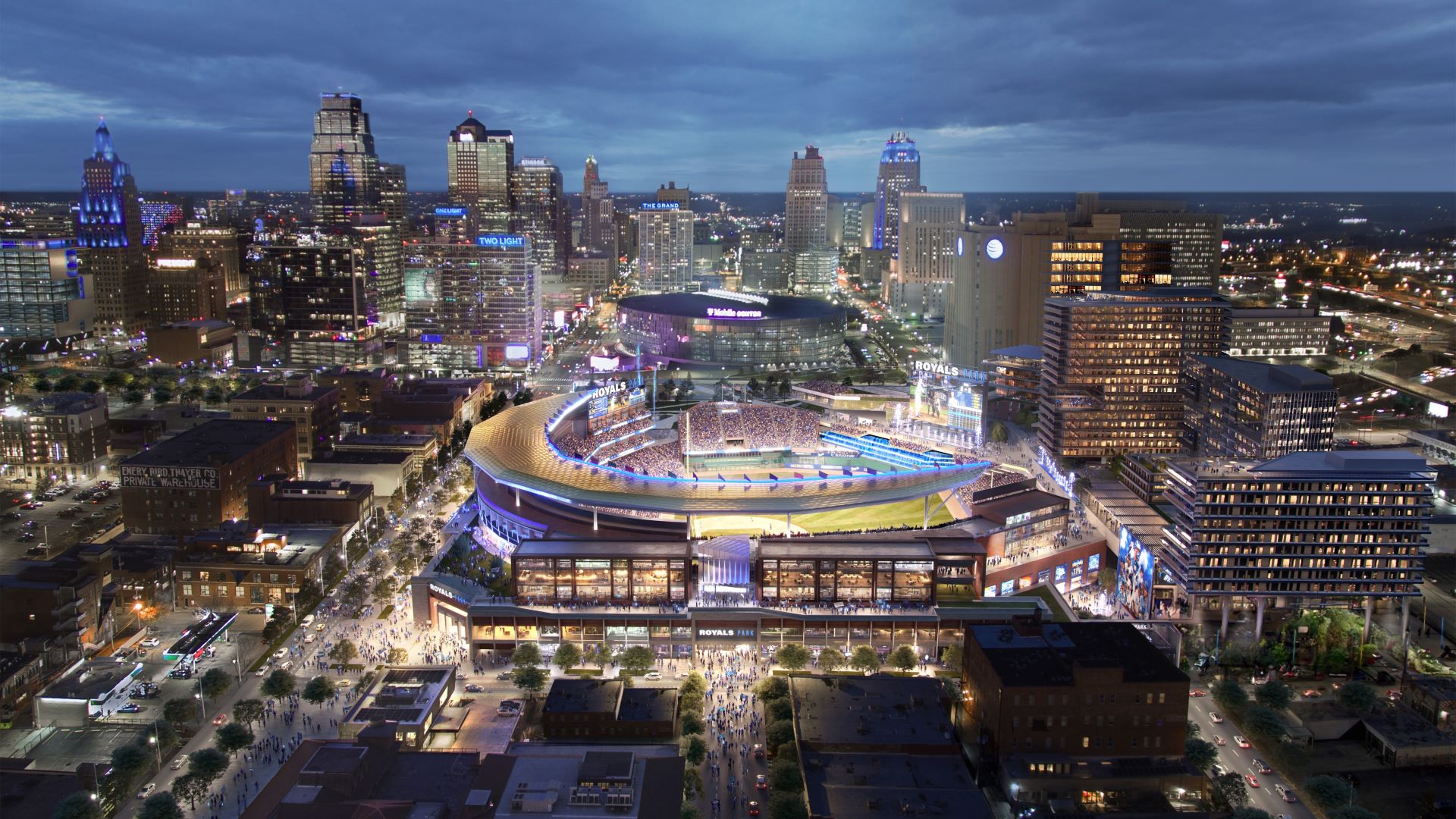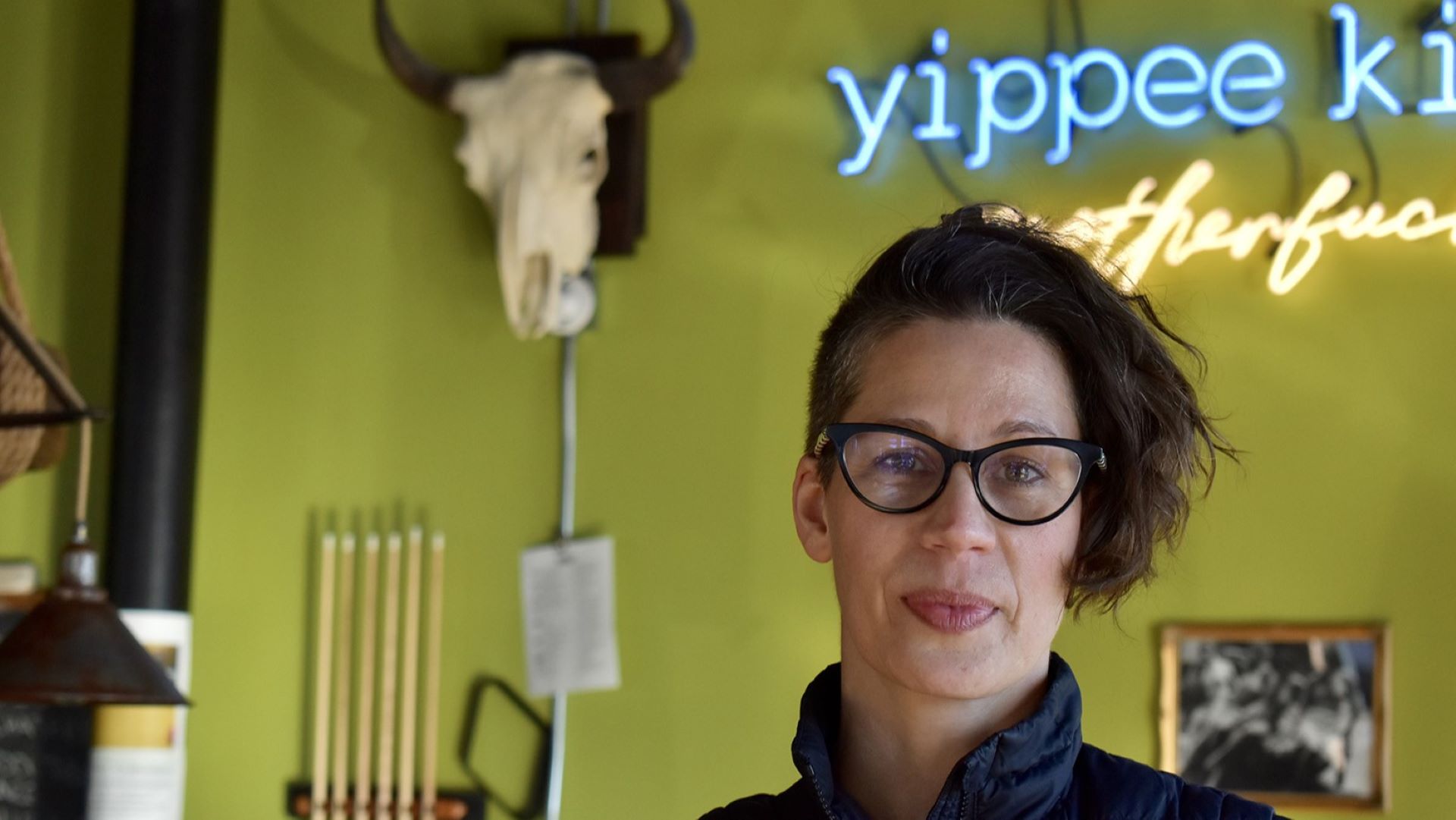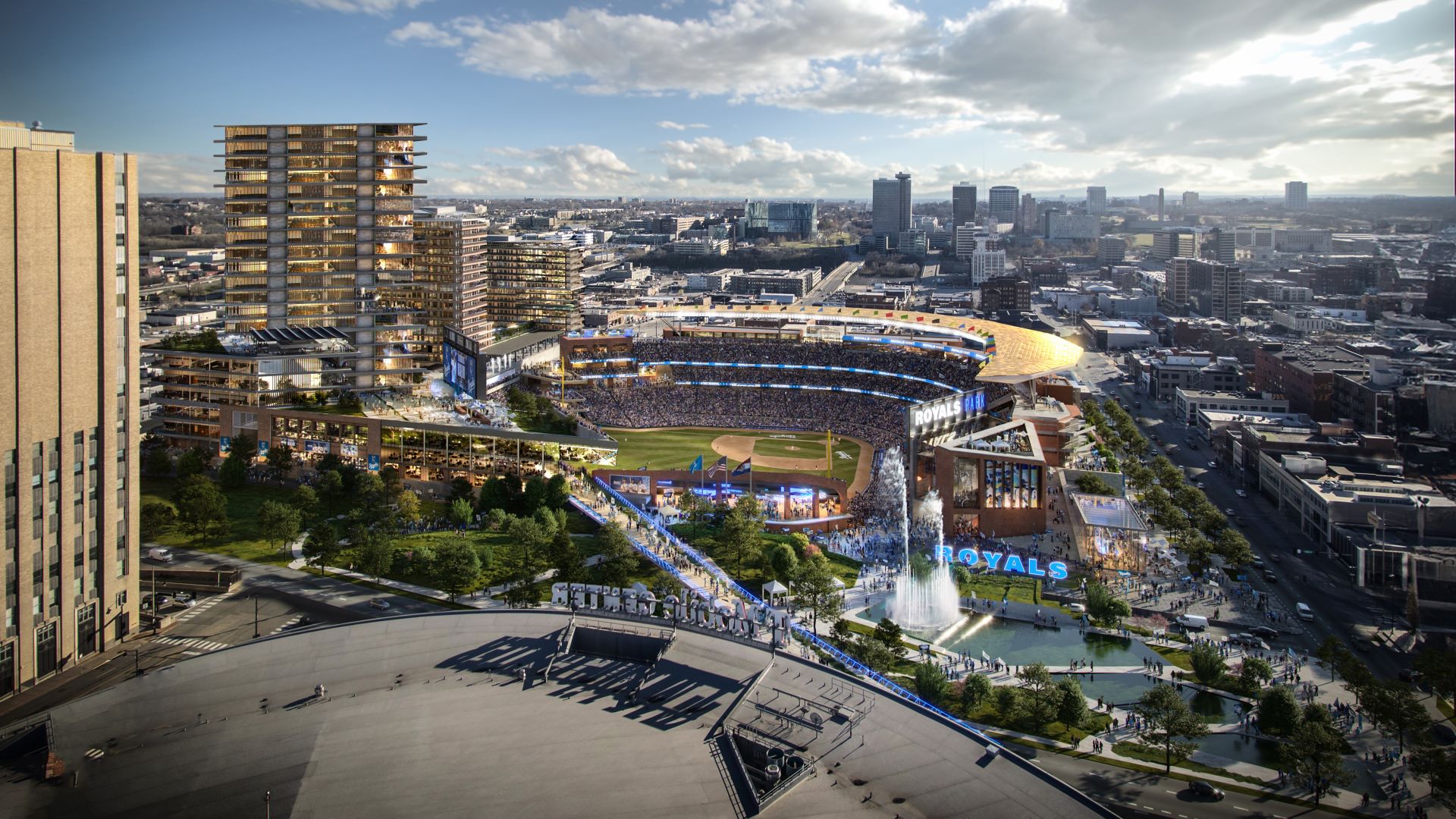Pondering Costs and Benefits of Royals and Chiefs Stadiums Jackson County Voters Scramble for More Information Before April 2 Vote
Published March 21st, 2024 at 6:00 AM
Above image credit: A view of the downtown skyline from inside the proposed Kansas City Royals ballpark. (Courtesy | Populous)As Kansas City prepared for the Chiefs Super Bowl championship parade, Royals CEO John Sherman on Feb. 13 unveiled plans to build the team’s new ballpark in the East Crossroads.
Just seven weeks later, Jackson County voters will decide on April 2 whether to pay a 3/8-cent sales tax for 40 years to help finance Arrowhead Stadium improvements and the new Royals ballpark.
On Wednesday, the Chiefs and Royals announced separate community benefits agreements (CBA) with Jackson County that the teams valued at nearly $270 million. Royals officials say they are also working on at least three other such agreements — with the Crossroads Community Association, ArtsKC and Kansas City Public Schools.
“As I have said from the very beginning, we are committed to Jackson County, and these historic agreements represent how both teams will help lift up our fellow neighbors – from providing workforce benefits and assistance, diversity benefits, affordable housing, educational programs, and expanded mass transit,” Sherman said in announcing the CBA with the county.
Not everyone is satisfied.
Separately, the Good Jobs and Affordable Housing for All Coalition — made up in part of the Heartland Center and labor groups like Stand Up KC and the Missouri Workers Center — gave the team until Tuesday to complete an agreement. When the deadline was missed, the coalition said it would encourage Jackson County residents to oppose the tax.
Many Crossroads business owners that would be displaced by the ballpark also have rallied to oppose it.
Crossroads business owners Jill Cockson, hospitality consultant and owner of Chartreuse Saloon, and Shawn Sherrill, a co-owner of recordBar, argue that the largely vacant East Village site made more sense for the ballpark.
“There was almost no community impact at that location,” Cockson said. “To hear that they chose…this site to announce as their preferred site just seems so unbelievable and completely tone-deaf.”
“I thought it couldn’t be real, but here we are,” Sherrill said.
Flatland in Focus
Big Deal, Big Decision
The April 2 ballot measure would end an existing 3/8-cent sales tax to support Truman Sports Complex and replace it with a new 3/8-cent sales tax for 40 years for Arrowhead improvements and the new ballpark in the Crossroads. The Chiefs and Royals would split the tax money 50-50, giving each team $27 million a year.
On KCUR’s “Up To Date”, Sherman said that roughly $300 million in county sales tax money would be dedicated to the ballpark. The team has said the Royals development budget calls for about $1 billion for the ballpark and $1 billion in related commercial development, which would be partially financed privately.
The 34,000-seat ballpark would consume four blocks between Grand Boulevard and Oak Street, and Truman Road and 17th Street. The area includes The Kansas City Star’s now-vacant, glass-clad former printing plant, Church of the Resurrection Downtown and various restaurant, retail and commercial buildings.
In addition to 81 annual home games, the Royals would also host various community events and concerts in the Crossroads. On the east side of the planned ballpark would be team and corporate offices, a hotel, and residential and entertainment spaces spanning two more blocks.
Rather than creating a competing entertainment district just a few blocks away, Royals officials say they chose the Crossroads site, in part, to leverage earlier public investments in the Power & Light District, T-Mobile Center and the KC Streetcar.
“I love this location,” Sherman said when he announced plans to build the ballpark downtown. “I think if you think about the (proposed South Loop Link) park, and you think about walking north into the Power & Light District or walking south into the Crossroads…this is really what baseball is all about.”
Playing Chicken
Professional sports franchises will always need venues. But demands for governments to help finance even more grand stadiums, ballparks and arenas have been escalating for decades.
Neil deMause, editor of the blog Field of Schemes, and his co-editor John Keegan have followed the sports development phenomena since the 1980s.
Team owners have realized selling tickets alone wasn’t going to make them any money if they were to build a new stadium themselves, deMause said. So, owners have embraced a model of having a third party build the new stadium with as much public money as possible.
“Team owners really see it now as vital to their profits,” deMause said. “You’re not only selling tickets for top price or getting what you can from cable and streaming rights or from the name of the stadium alone, regardless of whether you’re the one who actually owns it. But you’re also getting public money every 20, 30 years to build a new place…
“As long as it works, I’m not surprised that they continue to do it.”
The appeal for public subsidies typically plays out in one of two ways:
- The home team is performing well, as the Chiefs are, and a new stadium will reflect its quality and help it maintain that performance.
- The home team is struggling on the field, as the Royals have in recent years, so the only way it’s going to succeed is by getting a new stadium.
The specific risk with the second scenario is that the public may be in a place where they don’t trust the owner because of how poorly the team has been playing, deMause said. Since not that many fans are excited about the team, they may feel indifferent about the team leaving.
Officials with both the Chiefs and Royals have repeatedly said they would “explore all options” for stadiums if Jackson County voters reject the sales tax on April 2.
While opponents have been dismissive of such implied threats that the teams could move, Oakland, California, has lost NFL, NBA and MLB franchises in recent years because of stadium issues.
Moreover, Kansas City has its own long and rather tortured history of attracting and losing big-time professional sports franchises.
Notably, the Philadelphia Athletics major league baseball team moved to Kansas City in 1955. The Chiefs then moved from Dallas to Kansas City in 1963.
Soon thereafter, the Kansas City Athletics moved on to Oakland in 1968. In 1976, the Kansas City Scouts NHL hockey club moved to Denver. Finally, the Kansas City Kings NBA basketball franchise moved to Sacramento in 1985.
Costs and Benefits
Sports franchise migration has spawned an industry of economic analysis focused on the value of teams, and the stadiums they occupy, for the cities, counties and states that help finance them.
After several decades, the overwhelming conclusion of those studies is that the economic benefit is somewhere between little and none in terms of things like jobs, per capita income and tax receipts.
“It’s really across the board that these are really poor public investments,” said J.C. Bradbury, a Kennesaw State University economics professor.
Sly James, a former Kansas City mayor and consultant for the stadium tax campaign, countered that the benefits of teams and stadiums go beyond math.
“People sometimes want to draw everything down to dollars and cents,” James said. “These teams bring us a lot more than money. They are part of the pride that we have in this community.”
Even as the economic impact debate simmers, stadium deals keep getting larger. Adjusted for inflation, stadium subsidies have risen to a median of about $350 million in 2010 to about $500 million today.
“All the benefits are accruing to the team owners because they’re the ones whose team plays in a new stadium, they’re the ones selling tickets for higher prices, and are offering more food options,” deMause said.
“It’s an open question of whether they would be spending all this money if new stadiums with those perks were all they got out of it and they had to pay for out of their own pockets. But they don’t have to make that decision, right? They can have their cake and eat it too.”
The Royals aren’t the only MLB team proposing a new stadium.
Last year, the Tampa Bay Rays finalized plans for a new ballpark that is expected to cost around $1.3 billion, about half of which will come from city and county governments. Part of the public subsidy would be financed by taxes on tourists. The ballpark is part of a $6.5 billion development project that includes affordable housing and retail space.
The community benefits mentioned in the Rays’ stadium development plan include $13 million to support small businesses and funding for the construction of a new African American Museum.
Milwaukee Model
Some Kansas City area groups pushing for a worker-focused community benefits agreement point to Milwaukee as a model.
Pablo Aquiles-Sanchez — co-author with Laura Dresser of Worker Power Levels the Playing Field, a 2022 study from High Road Strategy Center based at the University of Wisconsin-Madison — examined the community benefits of public subsidies in Milwaukee’s proposed Iron District development. The Iron District would include a new soccer stadium surrounded by a mix of other uses.
Aquiles-Sanchez isn’t surprised Midwestern cities are looking to stadium development projects to revitalize urban neighborhoods.
The study found that Milwaukee policymakers could draw upon the Deer District Community Benefits Agreement, created in 2016 when the Milwaukee Bucks NBA franchise pushed for the new Fiserv Forum arena.
The successful CBA with the Bucks, negotiated and enforced by the community coalition Milwaukee Area Service and Hospitality (MASH), focused primarily on ensuring a fair unionization process for workers, minimum wage increases and setting up first-source, zip code-based hiring halls.
The CBA and strong oversight resulted in a higher wage floor that was negotiated sooner than originally planned, improvements in job quality for 1,000 full- and part-time union workers and greater diversity across hospitality industries in Milwaukee.
“It’s really, really important that city government officials want to do good by their constituents, and the greater community itself knows that there is an alternative to simply taking these developers’ offers at face value,” Aquiles-Sanchez said.
“There’s a way for workers in the community themselves to leverage these deals in order to raise the floor for themselves, and that has domino effects throughout the city.”
Dresser added: “The structure of a CBA is important. A lot of things get called community benefits agreements. A lot of them are unenforceable, or untransparent. People never follow up. In a community benefits agreement, you need someone you’re accountable to.”
If there are multiple CBAs in the works in Kansas City, Dresser warned that it will likely water down accountability, transparency and enforceability. Aquiles-Sanchez added that “easy to market” one-off promises of community philanthropy have less impact than long-term economic development.
“A union or workforce structure that reproduces good jobs and good wage standards across time and across different work sites is a little less sexy than saying, ‘Oh, we’re going to build like a park.’” Aquiles-Sanchez said. “We make the argument that good CBAs must attend to a labor question because it’s what’s going to live on as the stadium continues to function.”
The High Road Strategy Center revisited the issue in Covering The Bases, a new study focused on the Royals’ proposal.
“It is especially important to remember that public investment in these works reduces the public’s ability to buy other things. This money is not ‘free’ or untethered from public budgets. In Missouri, the structure of tax increment financing leaves schools without claim on public funds they desperately need,” the study states.
“Workers in rapid service jobs being able to negotiate pay and the structure of their work changes those jobs,” Dresser said. “Non-unionized service sector jobs generate high turnover, unsustainable lives for families – they’re just badly structured jobs. At least, the stadium should solve that, the people that are making money off the name, Kansas City.”
Correction: This story has been updated to reflect the fact that SEIU Local 1 is currently neutral on the stadium tax vote until a workforce benefits agreement is reached. Local 1 is no longer part of the Good Jobs Coalition.
Nicole Dolan is a freelance reporter assisting with “Flatland in Focus” on Kansas City PBS. Clarence Dennis is audience and digital content strategist with Flatland. Cody Boston is a multimedia producer for Kansas City PBS and the producer of “Flatland in Focus.” Julie Freijat, a masters student at the University of Missouri and a Flatland contributor, assisted with visualizations.












